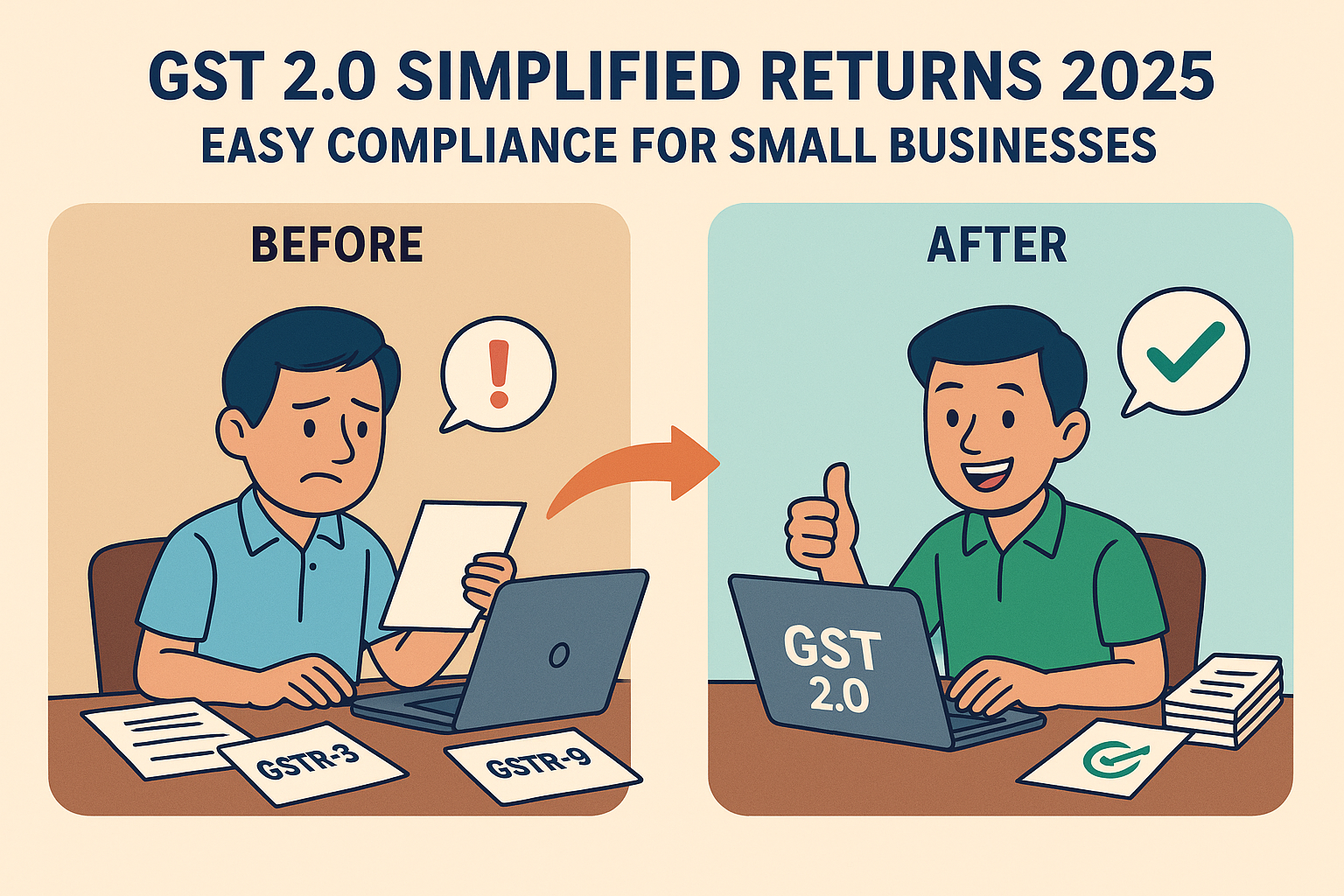The Goods and Services Tax (GST), launched in July 2017, was one of India’s biggest tax reforms aimed at unifying the nation’s indirect tax system. By replacing multiple state and central taxes with a single tax framework, GST 2.0 reduced cascading taxes and created a common national market.
However, while GST brought several benefits, it also created compliance challenges for small businesses. Multiple return forms, frequent reconciliations, and delays in Input Tax Credit (ITC) refunds made compliance complex and costly.
To address these issues, the GST Council introduced the draft framework of GST 2.0 Simplified Returns in September 2025. The new system promises easier compliance, reduced paperwork, real-time credit matching, and AI-powered fraud detection. Since small businesses form nearly 94% of registered GST taxpayers, this reform is expected to be a major relief.
Table of Contents
Why GST 2.0 Was Needed
Despite multiple amendments since 2017, MSMEs and small taxpayers continued to face hurdles in GST compliance. Some of the key problems included:
- Multiple Return Forms: Businesses had to file GSTR-1 (sales), GSTR-3B (summary), and annual returns, which created duplication of effort.
- Delayed ITC Refunds: Input Tax Credit refunds often took weeks or months, blocking much-needed working capital.
- Mismatch Issues: Differences between supplier and buyer returns triggered notices, penalties, and disputes.
- High Compliance Cost: MSMEs were forced to hire accountants or buy expensive GST software, increasing operational expenses.
With complaints growing and the government focusing on Ease of Doing Business, GST 2.0 was designed to make compliance simpler, faster, and more transparent.
Key Features of GST 2.0
The new GST 2.0 framework introduces several important features:
1. Single Monthly Return
Instead of filing multiple forms, small businesses will now submit one consolidated monthly return, merging GSTR-1 and GSTR-3B into a single form.
2. Invoice Upload & Auto-Fill
Businesses can upload invoices in real-time, and the system will automatically populate purchase and sales data, reducing errors and manual work.
3. Instant ITC Matching
Once a supplier uploads invoices, the buyer’s Input Tax Credit (ITC) will be approved automatically. This eliminates complicated reconciliations.
4. Quarterly Filing for Small Taxpayers
Small businesses with turnover up to ₹5 crore can opt for quarterly filing while continuing to pay taxes monthly.
5. AI-Based Fraud Detection
Artificial intelligence and advanced analytics will help detect fake invoices, reducing fake ITC claims while protecting genuine taxpayers.
6. Real-Time ITC Credit
Businesses will get ITC in real-time, improving liquidity and ensuring that their working capital isn’t stuck.
Benefits for Small Businesses
The new system is expected to significantly improve the ease of doing business for MSMEs:
- Less Paperwork – Filing one return instead of three saves time.
- Better Cash Flow – Faster ITC ensures more working capital is available.
- Lower Costs – Reduced dependency on accountants and consultants.
- Fewer Notices – Automated credit matching lowers errors and disputes.
- Encourages Registration – Easier returns will motivate more small traders to join GST.
Challenges to Watch GST 2.0
While GST 2.0 is promising, certain concerns remain:
- Technology Dependence – Businesses in rural areas may struggle with internet and software requirements.
- Transition Issues – Switching from the old return system to GST 2.0 may initially create confusion.
- AI Scrutiny – Genuine taxpayers may fear false positives from AI fraud detection.
- Quarterly vs. Monthly Payments – Although filing is quarterly, taxes still need to be paid monthly, which may burden very small traders.
Example: How GST 2.0 Helps an MSME
Consider a textile trader in Surat with a ₹3 crore annual turnover:
- Earlier, he filed GSTR-1, GSTR-3B, and annual returns separately.
- He spent nearly ₹50,000 per year on CA fees for compliance.
- Refund delays often blocked his funds.
Under GST 2.0:
- He can upload invoices directly.
- Get ITC instantly without waiting months.
- File just one quarterly return instead of multiple forms.
This saves both time and money, allowing him to focus more on business growth.
Benefits for the Government
While GST 2.0 eases compliance for businesses, it also benefits the government:
- Higher Compliance Rate – Easier returns encourage voluntary compliance.
- Reduced Fake ITC – AI-based tracking blocks fraudulent claims.
- Expanded Tax Base – Simplification attracts more small traders into the GST net.
- Improved Revenue Collection – Faster invoice uploads reduce leakages.
What Small Businesses Should Do
To prepare for GST 2.0, small businesses should:
- Get trained on the new GST 2.0 system.
- Adopt GST-enabled accounting software for smooth compliance.
- Stay updated with CBIC and GST Council notifications.
- Consult tax experts during the transition phase.
Conclusion
The upcoming GST 2.0 Simplified Returns is a major step towards making GST truly simple and business-friendly. By merging returns, offering real-time ITC, and leveraging AI for fraud detection, the government aims to balance ease of doing business with strong compliance.
If implemented effectively, GST 2.0 could transform compliance for India’s MSMEs and small businesses, reducing costs, improving cash flow, and strengthening trust in the tax system. Since these businesses form the backbone of India’s economy, GST 2.0 has the potential to bring both relief and growth opportunities.
Contact taxgiveindia.com for professional Services.
